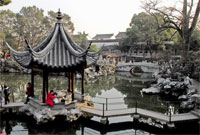Features of Chinese Garden
 Following the principle of integrating buildings with nature, a typical Chinese garden consists of the following parts:
Following the principle of integrating buildings with nature, a typical Chinese garden consists of the following parts:
Rockery
In order to represent the natural surrounding, rockery is very important in building gardens. Liangji in the Eastern Han Dynasty made two artificial mountains by imitation Yin Gorge and Luo Gorge, which is the start of? life-based gardening.
Water
In order to represent nature, water is also one of the most important elements in making garden. Visitors can enjoy the inverted reflection in water of the landscape, watch the swimming fish, admire the lotus, and view the bright moon from the water.
Plants
Plants are also one important element in decorating rockery and water. The flowers and trees are compared to hair of mountains. Waterscape will also loose aesthetic feeling without flowers and trees. The natural-styled gardens have three criteria in choosing plants in order to realize the pursuit of nature. The first criterion is appearance, for example, shape of crown of a tree, texture of bark, shape of leaf, and so on. The second criterion is color. Leaves, trunks and flowers must have various natural colors, for example, red maple leaves, verdant bamboo leaves, mottled elms, white yulan and purple osmund. The third one is fragrance. It is best to have fragrance in every month. The smell of calyx canthus is refreshing while that of orchid is delicate.
Buildings
Majestic classical buildings are built in the classical gardens. They look in harmony with the rockery, trees and flowers, and are together form the classical style of the gardens.
Classical gardens usually have building complex with one main building and several subsidiary buildings which are connected with each other. Such arrangement helps to give prominence to the main building. It does favor to the function and appearance of the gardens as well.
Buildings that are mostly common seen include halls, two-storied pavilions, multistoried buildings, main rooms, accommodation for guests, verandas with windows and studies. Any kind of the above buildings can be decorated as the main buildings. As the most representative buildings in the classical architecture, palaces, always tall and well decorated, are found in imperial gardens and emperors can have a rest in them. However, those in private gardens are still luxurious but simpler and the arrangement is more flexible.
Hall
Halls are buildings with public functions in ancient gardens, such as meeting guests, serving banquet, viewing plants and performances. Halls are always large in order to accommodate many guests. Doors and windows are well decorated and the whole building looks very elegant. Trees and flowers are planted in front of halls and rockeries are also made. Usually, halls have doors and windows on front and back sides. However, some halls have doors and windows in four sides.
Main Room
Main room is usually where the residence of the head of a family. It could also be used for family celebrations. Main rooms are always arranged on the middle axis and are well decorated. The spaces in the main room are separated by screens and purdah.
Multi-storied Building
Multi-storied buildings refer to the houses with more than one floor. They are always arranged behind the hall and main room, and are used for bedroom, schoolroom or for admiring landscape. Because they are relatively tall, they always become one scenic spot in the garden, especially for those built beside the water and mountain.
Multi-storied Pavilion
Similar to multi-storied buildings, multi-storied pavilions are smaller. They are always a two-storied pavilion with windows opened in four directions. Usually it is used for collecting books and viewing sights. Sometimes big figure of Buddha is worshiped here.
Terrace
Terraces are built by waters with short railings around. The terraces are used for admiring scenery and taking a rest.
Fixed Boat
The fixed boats in a classical garden are quite similar to painted pleasure boat. These boats can not move and are only used for having entertainment, serving banquet, and decorating the environment. The structure of a fixed boat is similar to a boat and can be divided into three parts, fore, middle and stern. The fore is for viewing scenery, the middle is for other activities. The fixed boats always have two stories. Steps are on the stern.
Corridor
The corridors are used to connect all the single buildings into a whole. The corridors always have one side facing the garden scenery. The columns and transoms constitute frameworks for finding different views.
Pavilion
Pavilions are small and unique buildings places at any places of the garden. They are usually used for taking a rest or shielding from the rain. The structure of a pavilion is quite simple. There are columns supporting the roof and a short wall by the columns. Seen from a plane view, pavilions can be classified as regular polygon shaped pavilion, rectangular pavilion, round pavilion, oval pavilion, compound pavilion, and so on. Seen from a solid view, they can also be classified as single-eaved pavilion, double-eaved pavilion and multi-eaved pavilion.
Pagoda
Pagodas are important Buddhist buildings. They are always at the center in the composition of a garden and are often borrowed as a part of the scenery inside the gardens.?
Bridge
Bridges are not only used for transportations, but also for decoration in the gardens.
Wall
Walls in the garden are used for dividing spaces. They are divided into interior wall and exterior wall. Walls have different figures, the mostly common seen kinds are whitewashed wall and cloud wall.